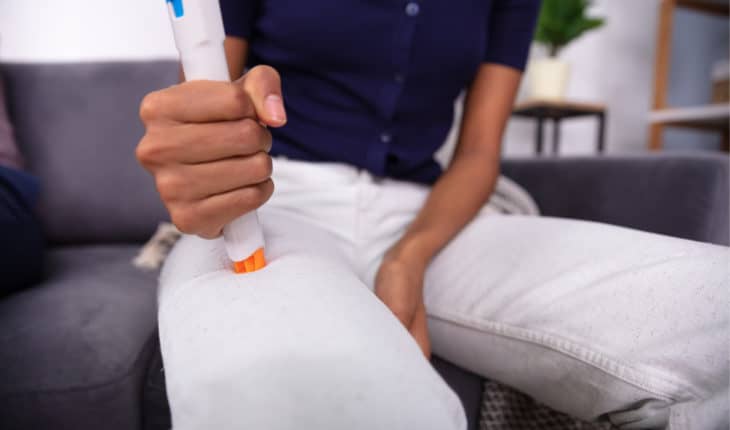Anaphylaxis and adrenaline auto-injectors: Anaphylaxis is an extremely severe allergic reaction. Reactions usually begin within minutes and progress rapidly, however, they can occur up to 2-3 hours after exposure. Exercise can also initiate symptoms a while after exposure to an allergen. Common allergens include food and insect stings.
In the UK, 5–8% of children have a food allergy. Anaphylaxis can proceed rapidly and failure to administer adrenaline promptly has been associated with fatalities.
Many children at risk of anaphylaxis are prescribed adrenaline auto-injectors (AAI) by their doctor. These devices should be swiftly accessible to them at all times. AAIs deliver a potentially life-saving dose of adrenaline in the event of a severe allergic reaction (anaphylaxis).
Why does anaphylaxis occur?
The body’s immune system reacts to a substance it wrongly perceives as a threat. It produces an “allergy” antibody called Immunoglobulin E (IgE), which sticks to the substance (“allergen”) and causes the release of chemicals including histamine. Histamine dilates capillaries in the skin, resulting in an itchy rash, swelling and flushing of the skin. A drop in blood pressure, leaves the casualty dizzy, light headed and in danger of collapse.

How to treat someone experiencing an anaphylactic reaction

In extreme cases, the allergic reaction can progress within minutes into a life-threatening reaction. The treatment of anaphylaxis is to give adrenaline, (usually using an autoinjector) by injection into the outer muscle of the mid-thigh.
Adrenaline treats the symptoms and stops it from becoming worse. Other “allergy” medicines, such as antihistamines can help with mild symptoms but are not effective for severe reactions (anaphylaxis). This is because they only reduce the histamine release and take up to 30 minutes to work – which may be too late.
How many doses of adrenaline should be given?
Administration of adrenaline can be lifesaving, but you may need more than one dose. Some anaphylaxis reactions require more than a single dose of adrenaline. It is therefore vital to always dial 999 and request an ambulance whenever anaphylaxis has occurred. Call 999 even if there has been a good response to the adrenaline injection.
There have occasionally been reported manufacturing faults which have resulted in the adrenaline autoinjector device failing to deliver the necessary dose. There are also issues with human mistakes. It is therefore recommended that anyone prescribed an adrenaline autoinjector, has immediate access to two at all times.
A second adrenaline auto-injector can be given 5 minutes after the first.
Adrenaline can be safely given by non-healthcare workers as an injection into the muscle using an adrenaline auto-injector (AAI). Current brands available in the UK are EpiPen®, Emerade®, Jext®. School staff should ideally have received appropriate training to be confident administering the medication.
Always give adrenaline FIRST in someone with known food allergy who has sudden-onset breathing difficulties. (Before other medicines such as asthma inhalers and even if there are no skin symptoms.) Delays in giving adrenaline are a common finding in fatal reactions. – advice from www.sparepensinschools.co.uk
IF IN DOUBT, give adrenaline. It is much better to give it early, or unnecessarily than too late!
For non-life-threatening reactions or localised swelling that does not impair breathing give an antihistamine, such as Piriton. Antihistamine tablets or elixir will take around 15 minutes to take effect.

If you have the latest version of the Epipen, you no longer need to hold for 10 seconds – just 2 will suffice. However, holding for longer will do no harm and there is such a problem with supply that people are unsure which version they have!
If you would like a copy of the above poster, please email me emma@firstaidforlife.org.uk and I would be delighted to send you one
Different makes of adrenaline auto-injectors

- Emerade: 150, 300 and 500 microgram doses available and the 500mcg dose has a longer needle, to allow for deeper fat penetration for larger children.
- Epipen: 150 and 300 microgram doses available. Epipen Junior delivers a 150 microgram dose
- Jext: 150 and 300 microgram doses available
Supply issues causing worrying problems
The high-profile death of Natasha Ednan-Laperouse and others who have died from anaphylaxis, has raised the importance of prompt access to emergency medication.
However, there have been major distribution problems with all three drug companies manufacturing the auto-injectors.
As a result, many pharmacies have been advised only to fulfil two auto-injectors – even if more have been prescribed. This has caused problems for parents, pupils, GPs and schools, all desperately trying to fulfil all requirements with a reduced supply.
Furthermore, unfortunately, many parents are resorting to buying auto-injectors online where they cannot be sure of the quality or source of their purchase.
Additionally, pharmaceutical companies have also been advising use of their auto-injectors beyond their expiry dates. Previous advice has been the adrenaline deteriorates becomes less potent beyond their expiry date. Manufacturers have issued occasional guidance resulting from these supply issues, indicating that certain doses of autoinjectors can be used up to 3 months after the stated expiry date.
Before using the adrenaline auto-injector, it is vital to check in the viewing window that the solution remains clear and colourless. Keep up to date with the latest drug company and Allergy UK guidance.
In response to the shortages, the Anaphylaxis Campaign have issued the following advice;
- If you are prescribed an alternative AAI device, ensure that you know how to use it and train others that may need to use it in an emergency.
- Always carry two adrenaline auto-injectors with you at all times.
- Ensure you have registered the expiry date of your devices on the relevant manufacturers websites to give you ample warning when a new prescription is required.
- Ensure you gain a replacement device prior to disposing of any out of date devices.
- Always make sure you have a trainer device which can be ordered from the manufacturer’s websites for free
- What is a seizure? - 13th March 2025
- Febrile Convulsions and Seizures in Children - 13th March 2025
- Why women are less likely to receive CPR or survive cardiac arrest - 6th March 2025






